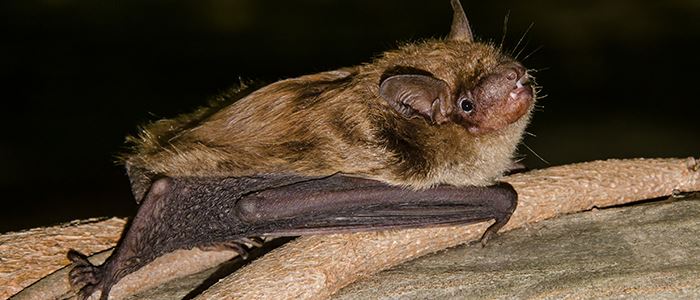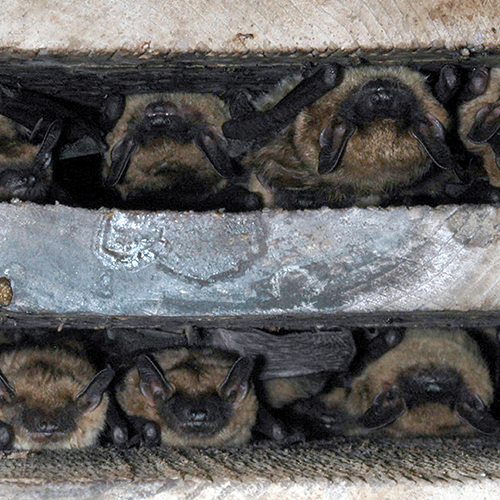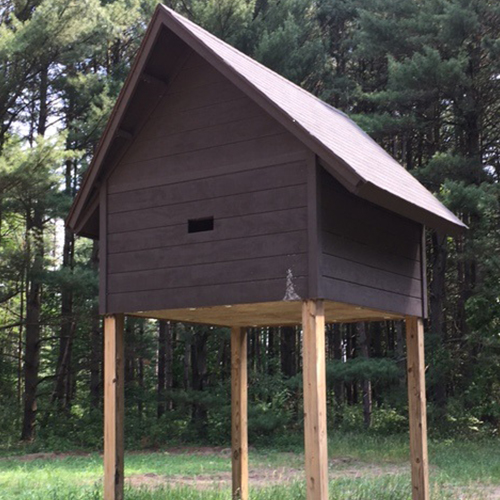A Condo of Bats

By Karen Menard
Tucked closely between 86 layers of quarter-inch thick, evenly spaced partitions, deeply sandwiched within a cavernous wooden structure, roughly 150 female big brown bats and their pups await the hour of sunset--when the nocturnal insects take to the skies.
This “condo” of sorts isn’t just any old place to get out of the weather, it was designed with purpose, recognizing a specific set of biological requirements, critical for survival and the overall success of the next generation.
These mammals decided on this hotspot with their pups in mind along with an awareness of their species’ ability and inability to regulate body temperature. Ideally, an adult big brown bat needs to spend the daytime hours sleeping in a safe, protected location, like a man-made structure or a hollow tree with the right specifications. However, the chosen space also needs to allow the bats to maintain consistent temperature regulation--enough to keep up an effective metabolism and a normal, elevated body temperature.
In order to accomplish that, their daytime roost microclimate will steadily need to register within the range of 85 and 100 degrees Fahrenheit. The resting body temperature of a big brown bat and its metabolic rate both rely on the surrounding air temperature, and keeping that number delivered with consistency within a man-made structure depends on the length of sun exposure, the shade color of the exterior, how well-sealed and insulated the structure is, as well as the availability of sufficient types of interior surfaces that their claws can cling to as they re-position.
Settling into a sustainable maternity colony roost, female big brown bats will also instinctually consider the needs of their pups who are left alone in the coolness of the dark at the roost each night as they venture out to find food. When these pups are young, they do not have the ability to regulate their body temperature and have adapted by being able to enter a state of torpor, which slows their metabolic rate. Additionally, researchers have found that evening fluctuations in temperature can also affect a young bat’s ability to produce strong and consistent isolation calls inside the roost. These individualized calls are particularly important for mothers in finding the accurate location of their own young upon returning to the site.
Taking all of these roost criteria into consideration is crucial for meeting the bat’s basic needs and will influence the likely success of any bat conservation project. Full size and mini condos are a great idea if your habitat or property is large enough and if the structures can be precisely built using the appropriate specifications. However, there are some other things to keep in mind to increase the likelihood of bats actually moving in.
The structure must be positioned so that much of it faces south and/or southeast in order to absorb at least around six to eight hours of morning to early afternoon sun daily. Painting or staining the exterior a medium brown color helps to absorb the most heat from the sun; however, keep in mind that the darker the color applied, the hotter the inside will get. Trees or shrubs 20-30 feet away can produce some shade from the more intense, afternoon sun, but it is important to make sure the vegetation isn’t growing too closely. Bats need a clear flight path when exiting and entering the area and are naturally wary of potential predators that may be lurking nearby. Height from the ground is recommended to be at least 8 feet, but more is always better, and fifteen to twenty feet is ideal.
Water does matter! A permanent water source like a pond, river, stream or lake that has a cleared perimeter within a quarter mile of the condo or box is essential. Bats drink while flying and need easy access soon after they emerge from their roost each day.
All of these specifications apply to the larger maternity roosts or condos and yet they also apply to box designs. The smaller scale boxes are mostly used by male big brown bats and are essentially, “bat”- chelor pads due to the fact that the females are primarily responsible for rearing the pups within the maternity colonies during the summer months. Males can be found roosting singly or with a few others in attics, building crevices, under tree bark, inside dead trees, or in small groups within bat boxes.


Did You Know?
The photo of this bat condo is located at Oak Openings Preserve Metropark and has been a maternity colony to Big Brown Bats since 2014! Each year a female has one young (or occasional twins). It is estimated that this colony has produced approximately 1,000 bats over this time period; and, exponentially, that’s A LOT of insects eaten over time.